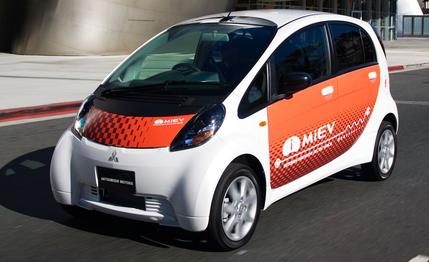
 Short Take Road Test
Short Take Road Test
For our test of the gasoline-powered Mitsubishi i, click here.


Check your skepticism at the door on entering the Mitsubishi i-MiEV, because at this moment, it takes a leap—no, more like a pole vault—of faith to believe that such electric nano-cars will eventually elbow their way into the American mainstream.
So far, this adorable little Martian garden slug of a car has only been sold in small numbers to Japanese government fleets and electric utilities, priced at about $53,000. We particularly like the look of the black-and-white unit sent to the Kanagawa Prefectural Police. “Starsky-san, somebody just blew a stop sign on a Segway. Rip the guts out of ’er!”
Adjustment Needed
However, if you’re forced to live with an i-MiEV for a while—say, for four days, as we did—then you might begin to be charmed, as we were. Because after four days of purring around Los Angeles, charging it off a 110-volt garage plug, and weathering the amused stares of fellow drivers in their petroleum hogs, we made an important discovery. If this is indeed the future, it’s not awful.
One caveat: Here in America, where the freeway is the only way, the i-MiEV won’t go the 100 or so miles on a charge that Mitsubishi says it’s capable of on Japanese fuel-economy cycles. Expect 50 to 60 miles with normal Yankee commuting patterns, maybe 70 if you’re very light on the go pedal and depend on routes with more stopping and starting, where the regenerative braking can benefit the range. If you’re able to charge while at work, even from an ordinary wall socket, the i-MiEV’s usefulness only increases.
Yes, It Is a Real Car
As with the gasoline Mitsubishi i, the i-MiEV is brilliantly packaged with more space inside than one would think possible. This egg is just 133.7 inches long and 58.0 inches wide. Headroom and legroom are generous, as is the cargo capacity, although it gets intimate when somebody takes the seat next to you.
Instead of a tachometer, the simple gauge cluster has a power-use meter that swings between green (power consumption, when you’re on the gas) and blue (power regeneration, when you’re coasting or on the brakes). Battery charge is indicated as with a fuel meter. Push a button, and it estimates the remaining range in kilometers. Electric motors and pumps supply the power-brake booster and the power-steering assist, as well as an air-conditioned chill or a toasted warmth to the cabin.
The gated shifter offers three drive modes: “D” for normal drive, “E” for eco, and “B” for battery. In the eco mode, the computer restricts the output from the 63-peak-hp permanent-magnet drive motor and its one-speed gear-reduction transmission, even if you floor it. It’s also slightly more aggressive about switching the motor to regenerative mode, which drags down speed more quickly. In battery mode, it supplies full power on acceleration but turns up the regen effort even more. Lift the gas, and it feels as though you’ve suddenly driven into deep snow, the car decelerates so suddenly. Most of the time, D is the best choice.
At 13.5 seconds, the rear-drive i-MiEV’s 0-to-60-mph sprint is 0.8 second quicker than that of the AWD gasoline i we tested at the same time. True, the electric motor delivers its 133 lb-ft of torque at 0 rpm, but the electric i also weighs 240 more pounds than the dino-fueled model. Still, that’s quick enough to scamper up to freeway merge speeds without completely risking life and limb, although you’ll likely want to use long on-ramps. The instant torque also allows the i-MiEV to keep the pace when traffic lights turn green. Indeed, it melds into traffic flows with surprising ease and is generally more fun to scoot around in than the gas model, with light, quick steering and firm brakes backed up by the regenerating motor.
We See Potential
Is the i-MiEV’s range a deal killer? In L.A., the sprawl is roughly 100 miles by 100 miles and bisected by a few mountain chains, so it’s certainly a consideration. Given the performance afforded by the 330-volt lithium-ion battery pack, the 14-hour recharge time on a household 110-volt plug, along with a price that Mitsubishi hopes will be “under $30,000,” the i-MiEV has its challenges cut out for it. Buyers will almost certainly have to hire an electrician to adapt the factory quick charger—it shortens recharging from 14 hours to an 80-percent recharge in 30 minutes—or install a 220-volt, 15-amp outlet if they don’t have one. That cuts the recharge time to seven hours, or basically overnight.
We charged a vastly more power-consumptive Tesla roadster on a 220-volt, 30-amp circuit we made out of $20 in Home Depot bits. This is not rocket science, nor is it an insurmountable market obstacle for an electric vehicle to overcome. The phonebook is filled with licensed electricians.
Obviously, the i-MiEV won’t be for everyone. Nor will the comparatively gigantic Nissan Leaf or electric Ford Focus be when they arrive. Electrics are strange to most folks and, at the moment, absurdly expensive, and the i-MiEV’s size alone will hinder its market acceptance. But consider that in densely packed Japan, the gasoline-powered version of the i-MiEV is a perfectly acceptable choice for a family of four on a budget. America is expected to pick up another 100 million citizens by 2050, and in some localities we are surely headed in the same miniaturizing direction as Japan went years ago. The i-MiEV might not be the future, but there’s a good chance the future won’t look or drive all that different. Imagine New York’s Fifth Avenue, Paris’s Champs-Élysées, or London’s Piccadilly Circus, chockablock with i-MiEVs and the like, the whispering traffic only seen and not heard or smelled or gagged on. That future could be a lot worse.